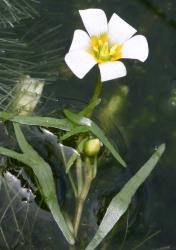Perennial herbs, aquatic; rhizomatous. Co-sexual. Stems with air canals, crystals present; indumentum of mucilage-producing trichomes, submerged parts, stems and petioles covered in mucilage (a thick sheath in Brasenia only). Leaves di- (Cabomba) or monomorphic (Brasenia), petiolate; submerged leaves (Cabomba only) opposite or whorled, non-peltate, palmately divided into di- and trichotomously dissected capillary segments; floating leaves, alternate, peltate, elliptic, linear, hastate or sagittate. Peduncles axillary or extra-axillary to a floating leaf. Flowers bisexual, solitary; perianth present, hypogynous, actinomorphic, in two whorls of trimerous petaloid tepals (rarely di- or tetramerous), the outer slightly connate at base. Androecium 3–36(–51) stamens; pollination syndrome entomophilous (Cabomba) or anemophilous (Brasenia). Gynoecium (1–)3–18(–22), apocarpic, placentation ascidiate, post-genital carpel closure incomplete, stigma capitate with multicellular papillae; ovules 1–3(–5) per carpel. Fruit follicle-like.
A family of six species in two genera, the Cabombaceae is found across tropical and temperate areas of Australia, the Americas, eastern Asia and Africa. Brasenia with the single species B. schreberi has an unusually widespread and disjunct distribution, which Löhne et al. (2008) hypothesise as relictual, whereas the genus Cabomba with five species is restricted to the Americas. Bory (1822), who circumscribed the family, considered it belonged to the monocotyledons. Bentham & Hooker (1862) and Caspary (1878) treated the two genera within the Nymphaeaceae. Angiosperm Phylogeny Group (2009) treated it as optional within Nymphaeaceae or as a separate family (Angiosperm Phylogeny Group 2003). There is a general acceptance that Brasenia and Cabomba should be treated as a separate family based on morphological and molecular evidence (Ørgaard 1991; Löhne et al. 2007; Taylor 2008; Gruenstaeudl et al. 2017).
The flowers of the two genera appear very different owing to different pollination syndromes. Brasenia is wind-pollinated and Cabomba insect-pollinated, but both have a perianth with six tepals in two whorls of three (giving a monocot appearance) and a superior gynoecium with distinctive large free carpels relative to the flower. The carpels are elongated and tapered distally and the stigmatic area has conspicuous multicellular papillae.
Eastern Australia, North and South America, eastern Asia, and central to southern Africa.
| Category | Number |
|---|---|
| Exotic: Casual | 1 |
| Total | 1 |




